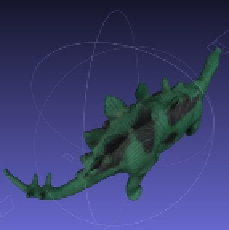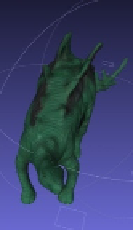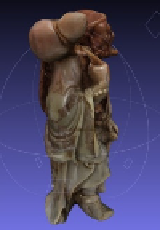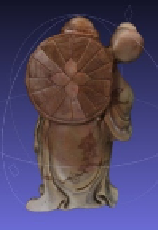Graphics Reference
In-Depth Information
Fig. 19.
Reconstructed models
5
Discussion and Conclusion
In this paper we justified several properties of the chess-board vertices and designed a
multi-scale detector with which we develop an accurate and robust chess-board corner
detection algorithm that, according to experiments, performs well even in
ill-illuminated and ill-focused conditions. The accuracy and robustness of our detector
allows it to be employed in more applications related to chess-board detection. It can
also help to refine the vertices detected by other methods.
Acknowledgements.
This research was supported by Grant No 2010CB328002 from
The National Basic Research Program of China(973 Program), Grant No.
61232014,61121002,61173080 from National Natural Science Foundation of China.
Also was supported by Grant No. 2013BAK03B07 from The National Key Technology
Research and Development Program of China.
References
1.
Moravec, H.: Obstacle Avoidance and Navigation in the Real World by a Seeing Robot
Rover. Tech. Report CMU-RI-TR-3 (1980)
2.
Harris, C., Stephens, M.: A Combined Corner and Edge Detector. In: Proceedings of 4th
Alvey Vision Conference, pp. 141-151 (1988)
3.
Mokhtarian, F., Suomela, R.: Robust Image Corner Detection Through Curvature Scale
Space. IEEE Transactions on Pattern Analysis and Machine Intelligence 22(12), 1376-1381
(1998)
4.
Canny, J.F.: A computational approach to edge detection. IEEE Trans. Pattern Anal. Mach.
Intell. 8, 679-698 (1986)
5.
Rosten, E., Drummond, T.: Fusing Points and Lines for High Performance Tracking. IEEE
International Conference on Computer Vision 2, 1508-1515 (2005)
6.
Escalera, A., Armingol, J.M.: Automatic chessboard detection for intrinsic and extrinsic
camera parameter calibration. Sensors 10(3), 2027-2044 (2010)
7.
Yu, C., Peng, Q.: Robust recognition of checkerboard pattern for camera calibration. Optical
Engineering 45(9), 093201 (2006)




Search WWH ::

Custom Search